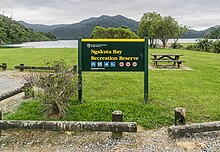Ngākuta Bay
Ngākuta Bay | |
|---|---|
 Ngākuta Bay | |
 | |
| Coordinates: 41°16′23″S 173°57′43″E / 41.273°S 173.962°E | |
| Country | New Zealand |
| Region | Marlborough |
| Ward |
|
| Electorates | |
| Government | |
| • Territorial Authority | Marlborough District Council |
| • Marlborough District Mayor | Nadine Taylor |
| • Kaikōura MP | Stuart Smith |
| Area | |
• Total | 0.31 km2 (0.12 sq mi) |
| Population (June 2024)[2] | |
• Total | 60 |
| • Density | 190/km2 (500/sq mi) |
Ngākuta Bay is a settlement and bay in the Marlborough Sounds, New Zealand. The bay is part of Grove Arm in Queen Charlotte Sound / Tōtaranui. Picton is about 11 km to the southeast via Queen Charlotte Drive. The bay was given its official name of Ngākuta Bay on 27 May 2021[3] and it has been known as Ngakuta Bay since at least 1865.[4]
Naming
Ngākuta is a combination of the Te Reo Māori words ngā,[5] meaning plural "the", and kuta,[6] a name for the tall spike sedge Eleocharis sphacelata. Together ngākuta means "the tall spike sedges".
Demographics
Ngākuta Bay is described by Statistics New Zealand as a rural settlement. It covers 0.31 km2 (0.12 sq mi)[1] and had an estimated population of 60 as of June 2024,[2] with a population density of 194 people per km2. It is part of the larger Marlborough Sounds East statistical area.[7]
| Year | Pop. | ±% p.a. |
|---|---|---|
| 2006 | 60 | — |
| 2013 | 63 | +0.70% |
| 2018 | 57 | −1.98% |
| Source: [8] | ||

Ngākuta Bay had a population of 57 at the 2018 New Zealand census, a decrease of 6 people (−9.5%) since the 2013 census, and a decrease of 3 people (−5.0%) since the 2006 census. There were 33 households, comprising 24 males and 33 females, giving a sex ratio of 0.73 males per female. The median age was 68.0 years (compared with 37.4 years nationally), with 3 people (5.3%) aged under 15 years, 6 (10.5%) aged 15 to 29, 15 (26.3%) aged 30 to 64, and 33 (57.9%) aged 65 or older.
Ethnicities were 94.7% European/Pākehā, 5.3% Māori, 0.0% Pasifika, 0.0% Asian, and 0.0% other ethnicities. People may identify with more than one ethnicity.
Although some people chose not to answer the census's question about religious affiliation, 47.4% had no religion, 42.1% were Christian and 0.0% had other religions.
Of those at least 15 years old, 12 (22.2%) people had a bachelor's or higher degree, and 9 (16.7%) people had no formal qualifications. The median income was $26,700, compared with $31,800 nationally. 9 people (16.7%) earned over $70,000 compared to 17.2% nationally. The employment status of those at least 15 was that 15 (27.8%) people were employed full-time, 9 (16.7%) were part-time, and 0 (0.0%) were unemployed.[8]
References
- ^ a b "ArcGIS Web Application". statsnz.maps.arcgis.com. Retrieved 21 July 2023.
- ^ a b "Aotearoa Data Explorer". Statistics New Zealand. Retrieved 26 October 2024.
- ^ "Notice of Approved Official Geographic Names in Marlborough Region". New Zealand Government. 27 May 2021.
- ^ "List of Persons who, during the Months of January, February, and March, 1865, have Preferred Claims to have their Names placed upon the Electoral Roll for the Electoral District of Picton". Marlborough Press. 8 April 1865. pp. 2–3.
- ^ "Ngā". Māori Dictionary. Retrieved 3 February 2022.
- ^ "Kuta". Māori Dictionary. Retrieved 18 August 2021.
- ^ 2018 Census place summary: Marlborough Sounds East
- ^ a b "Statistical area 1 dataset for 2018 Census". Statistics New Zealand. March 2020. 7023247.
